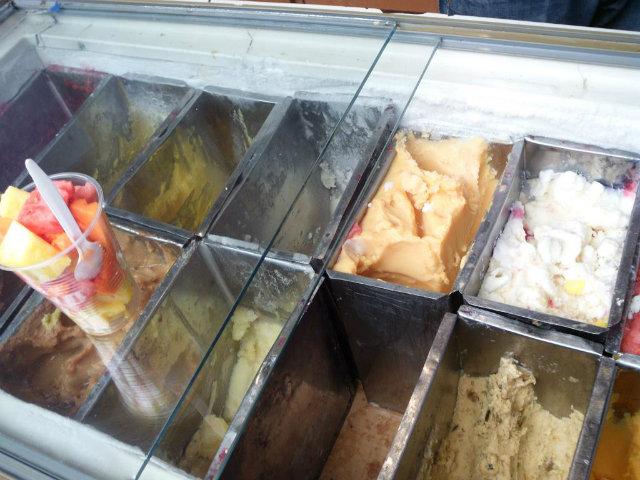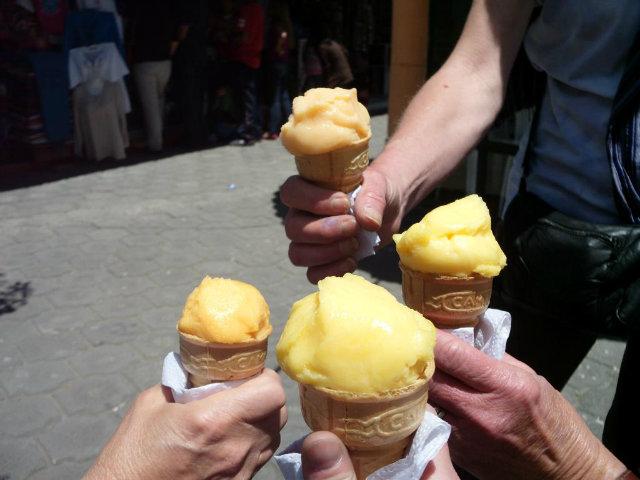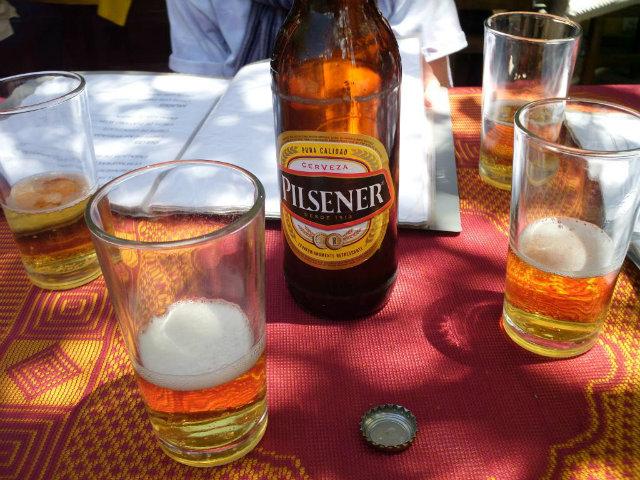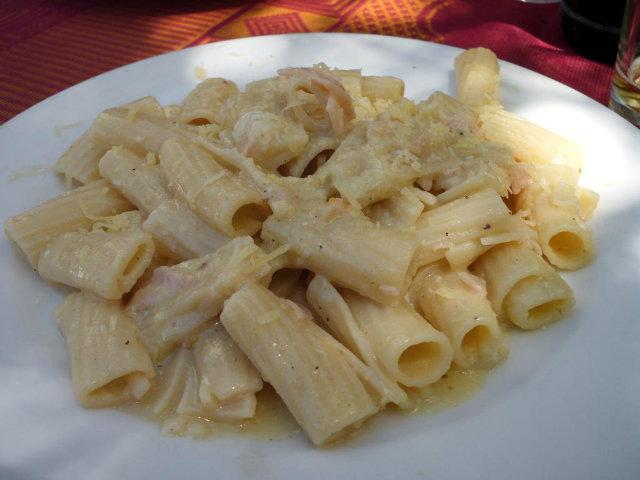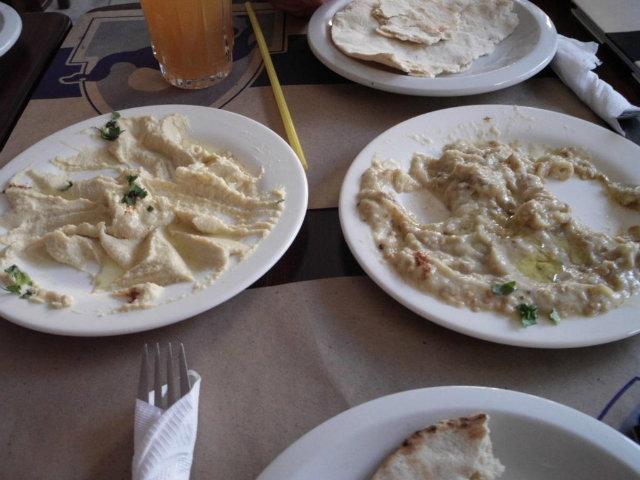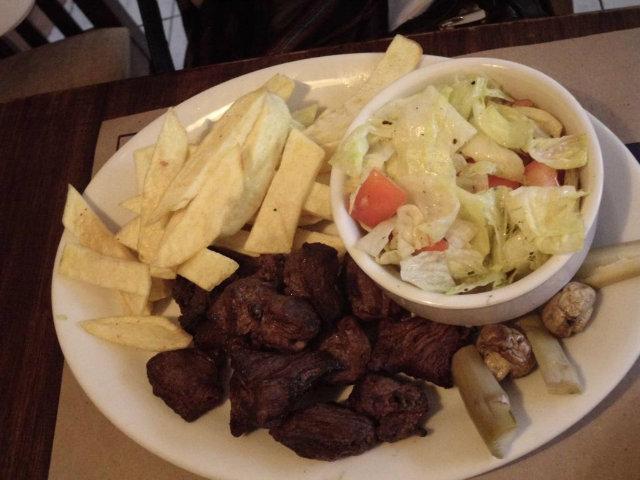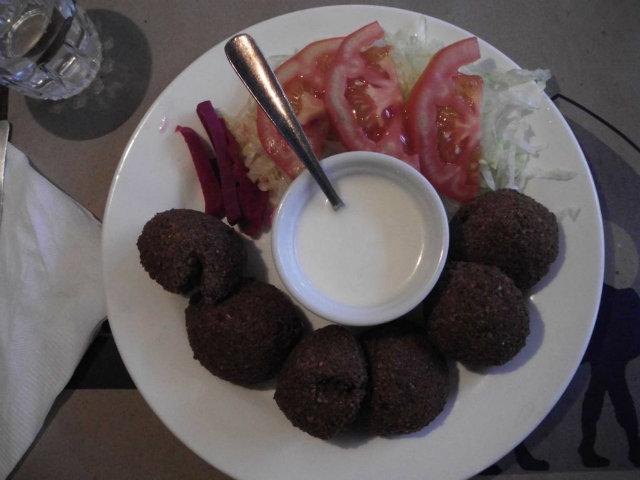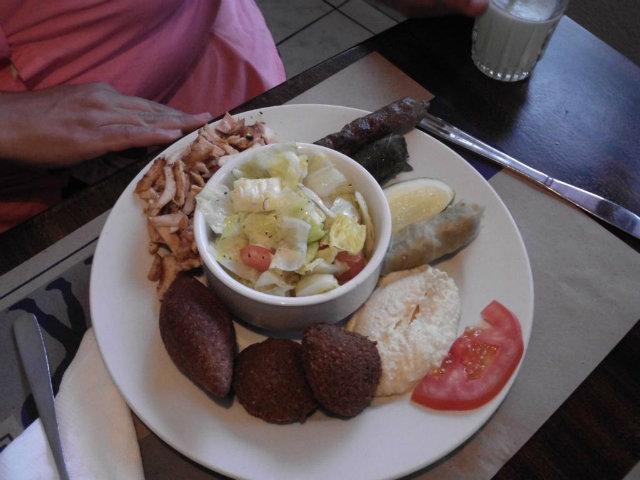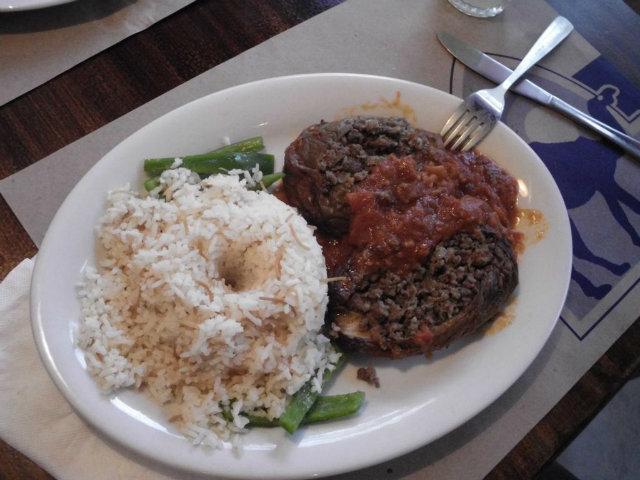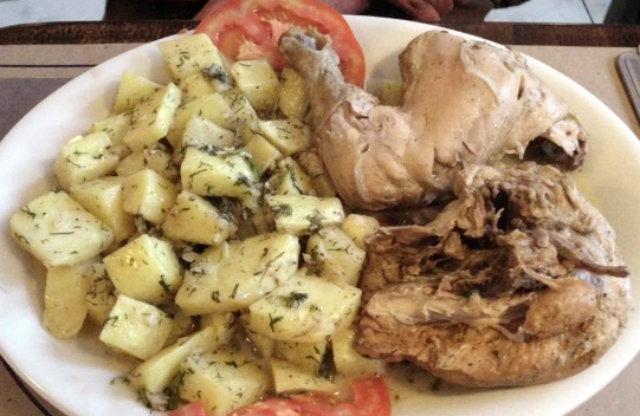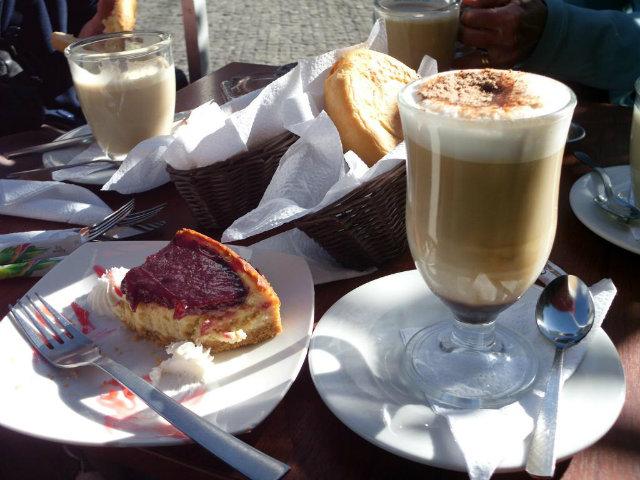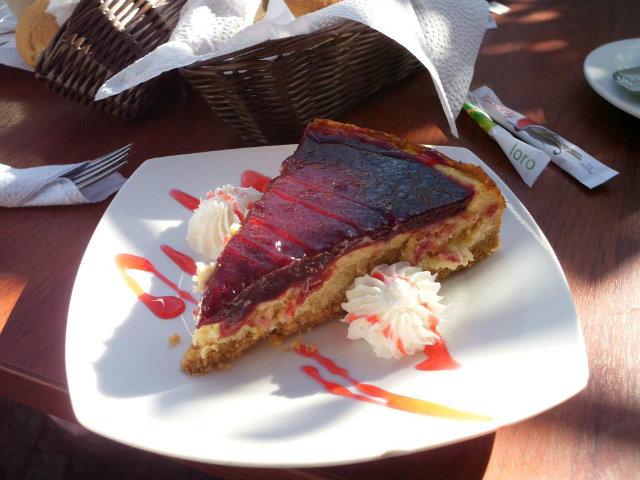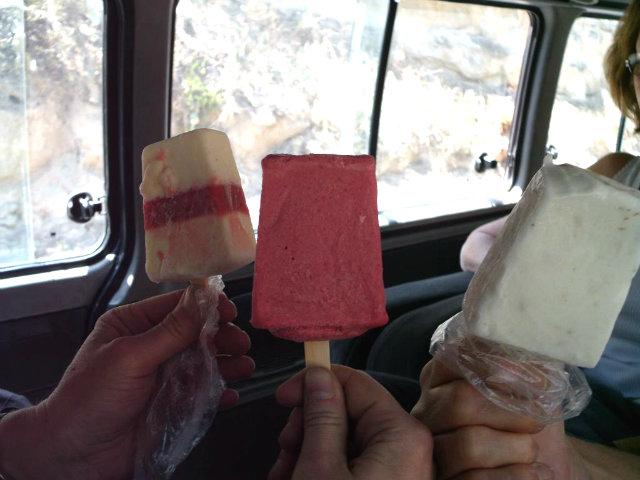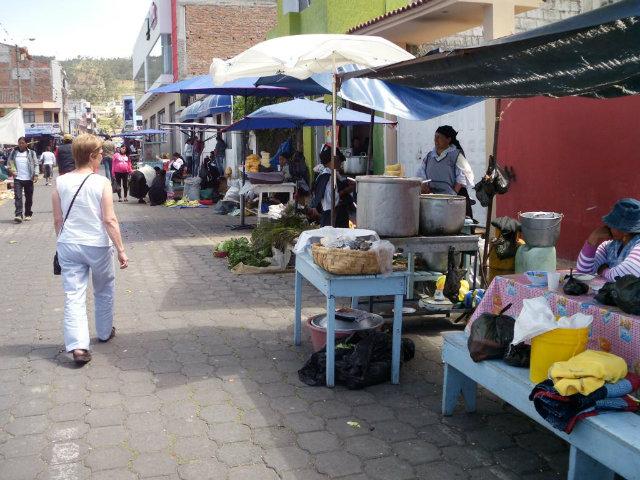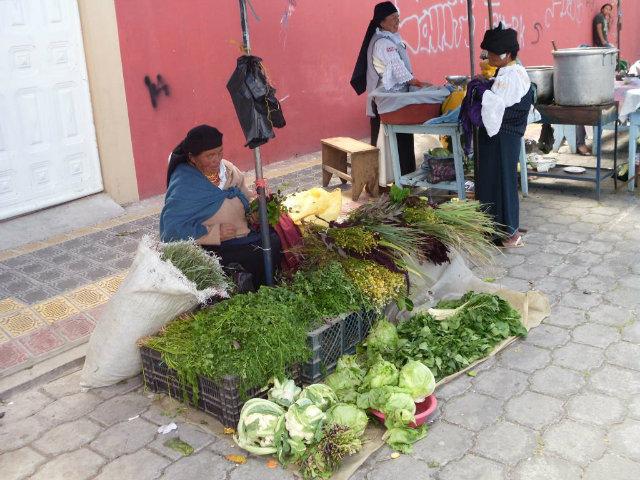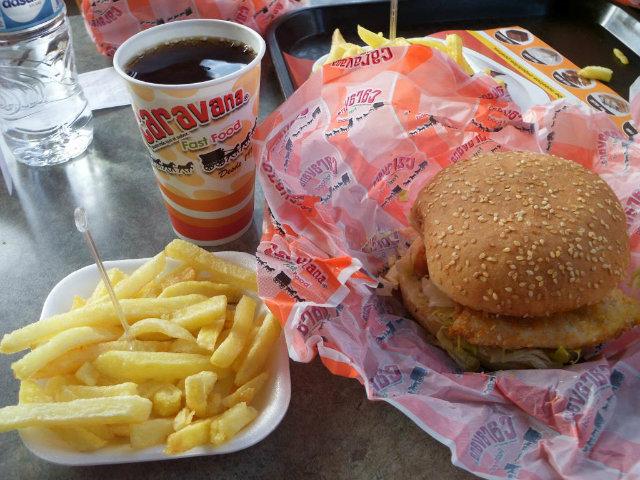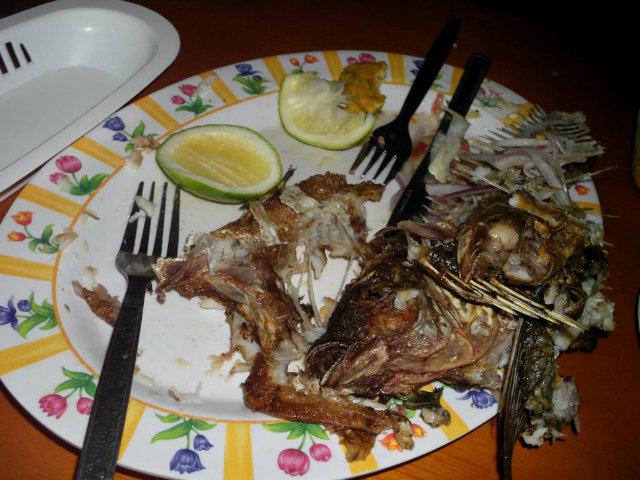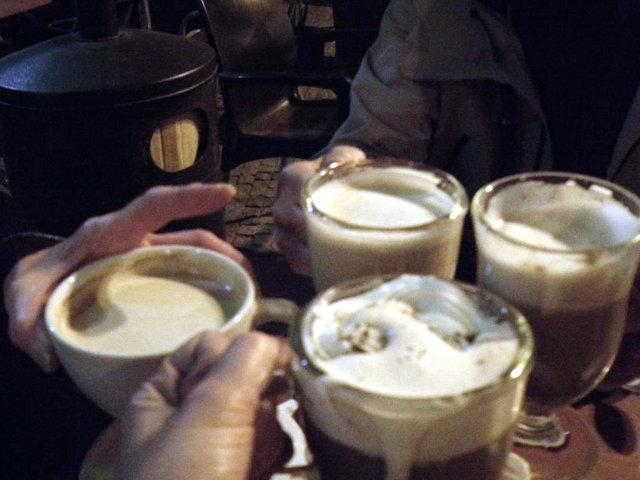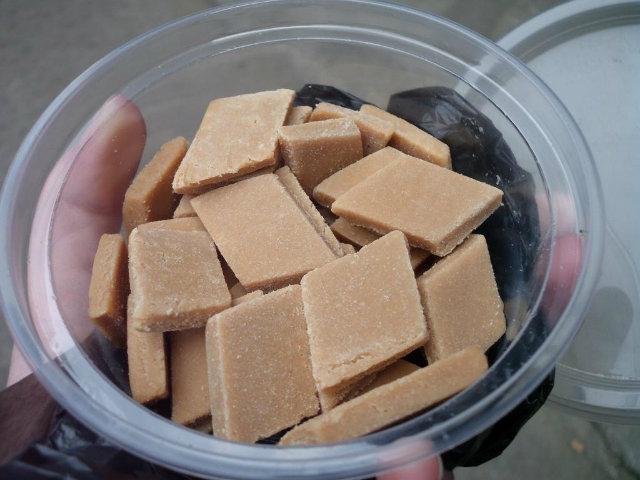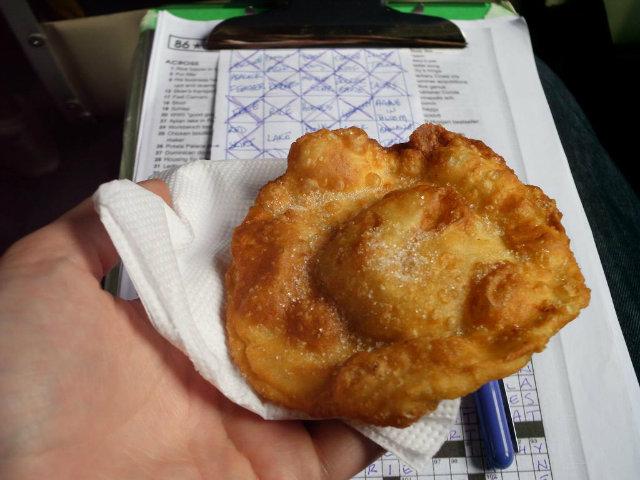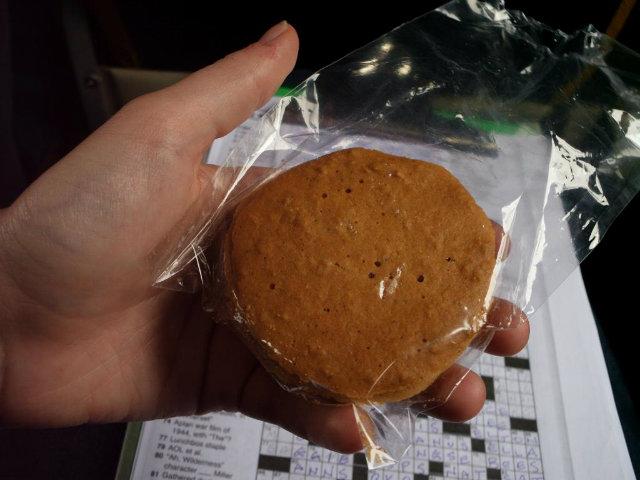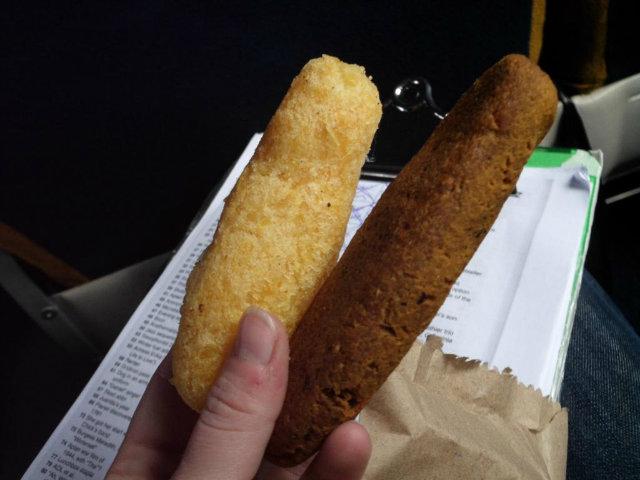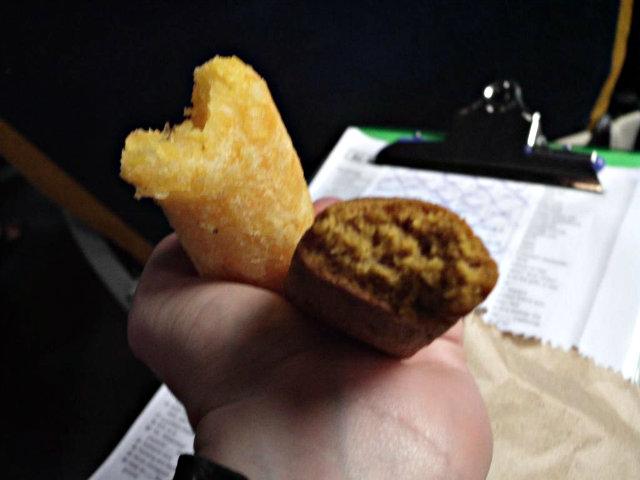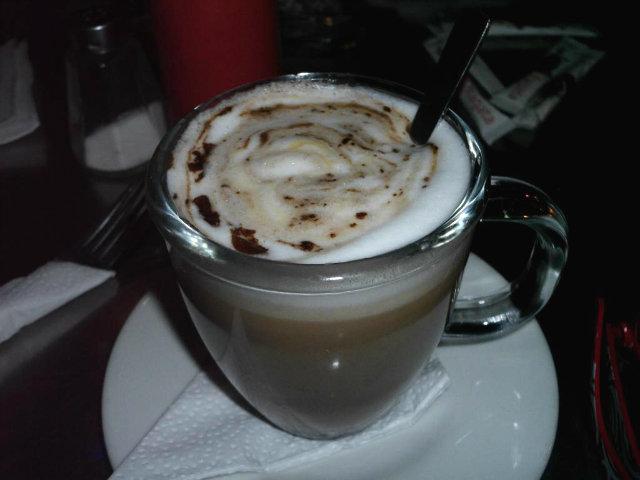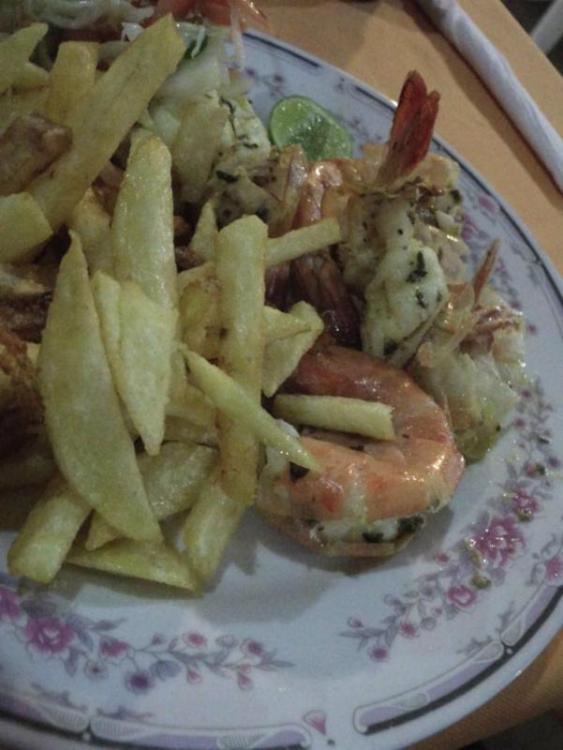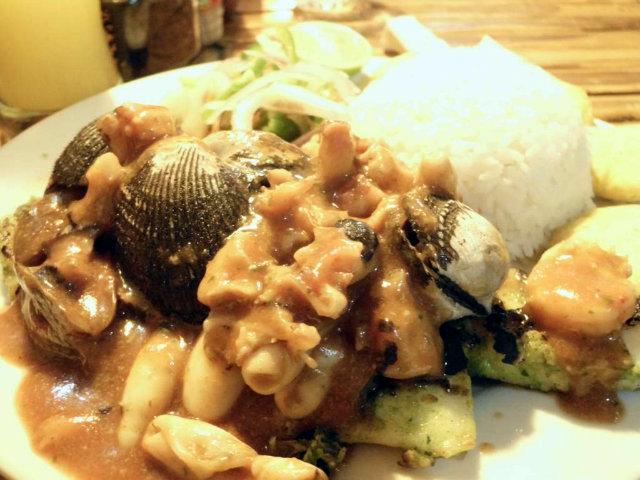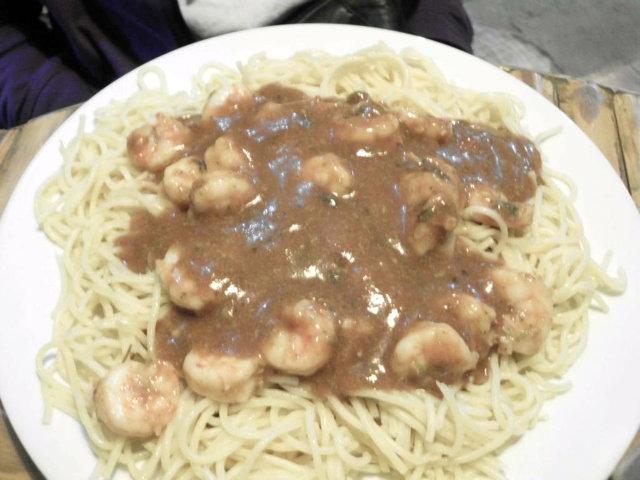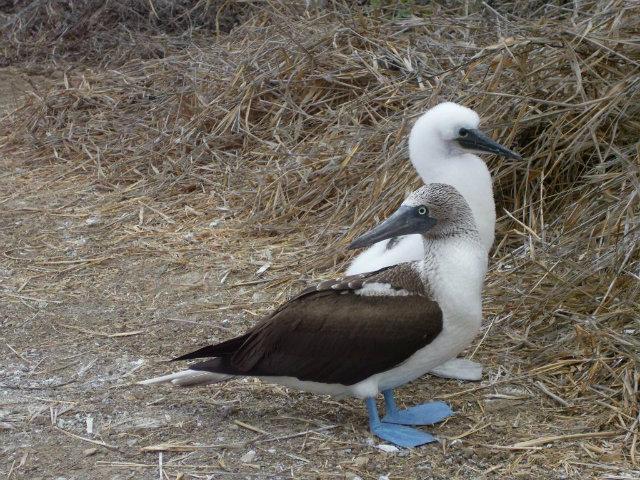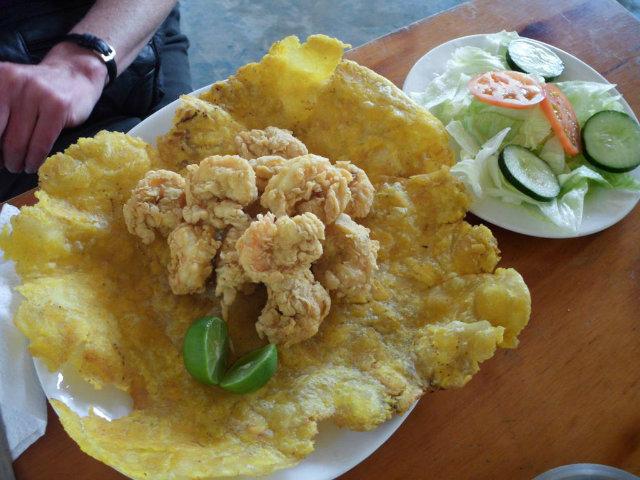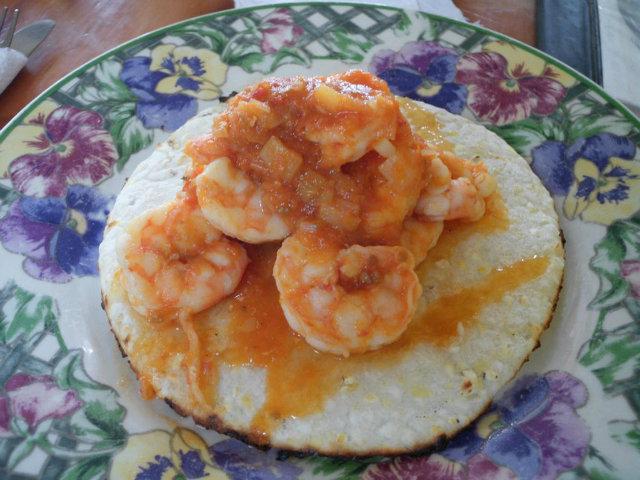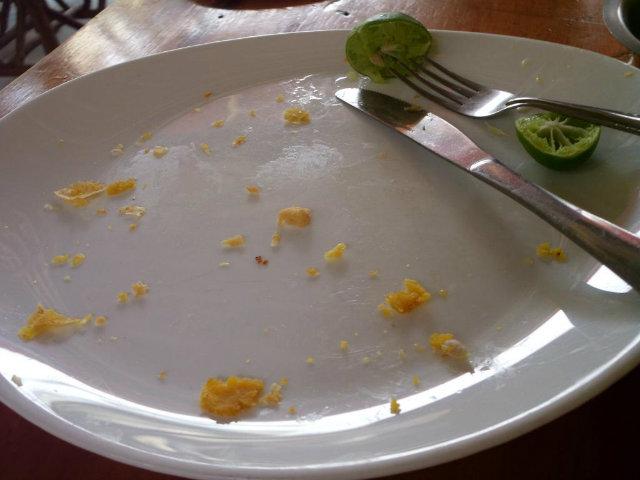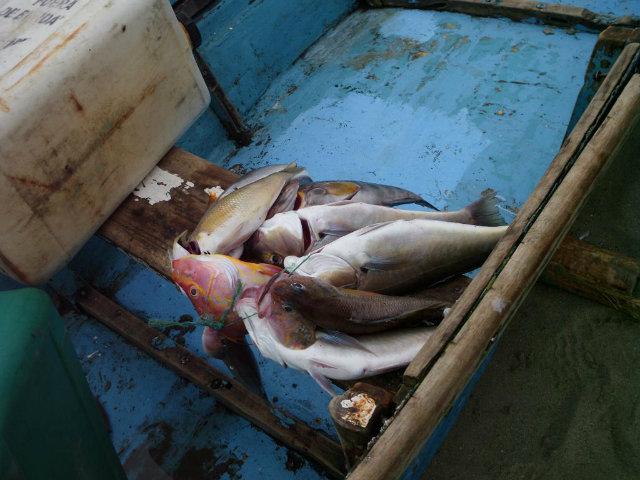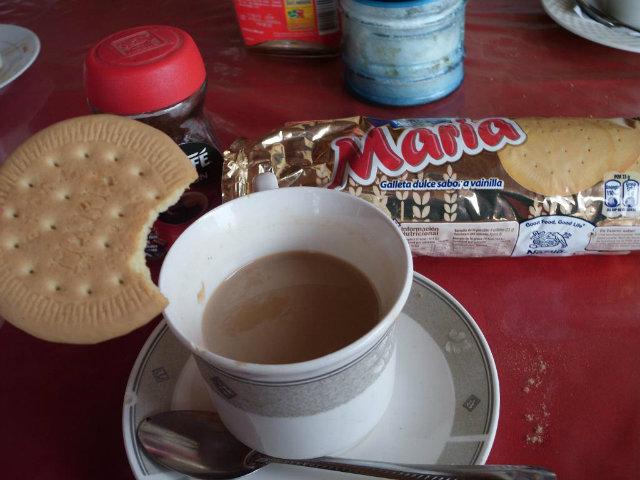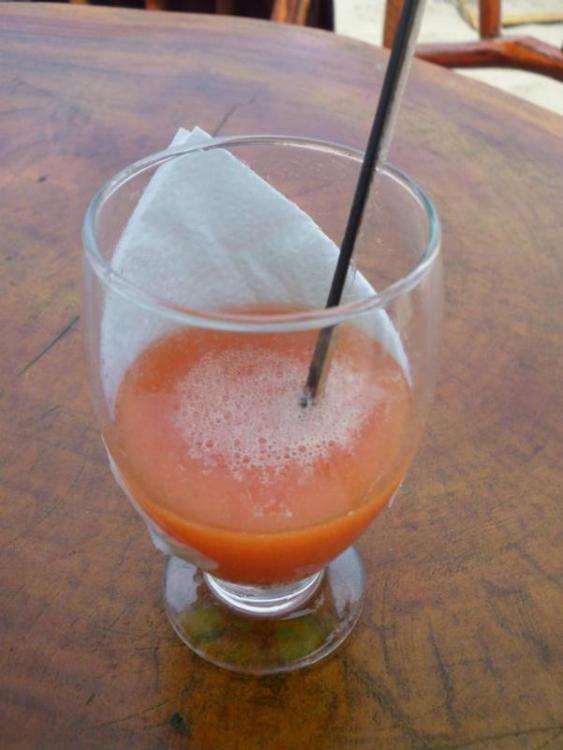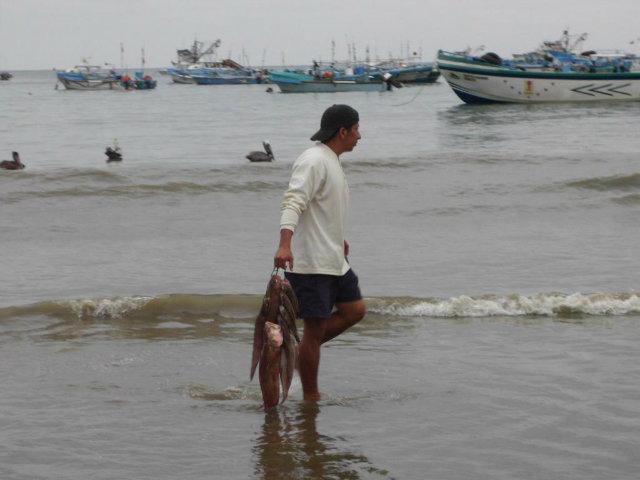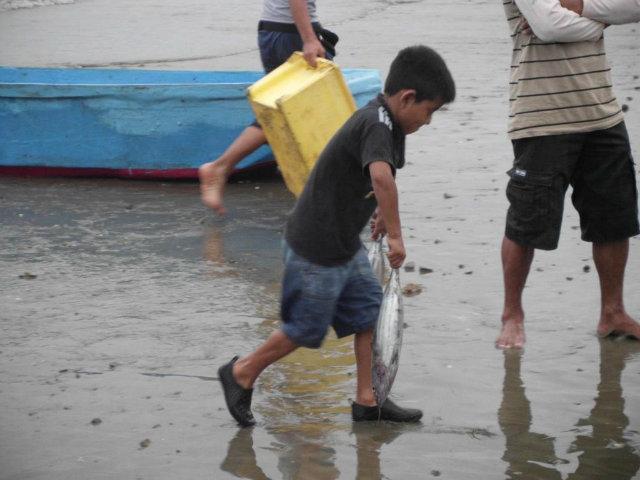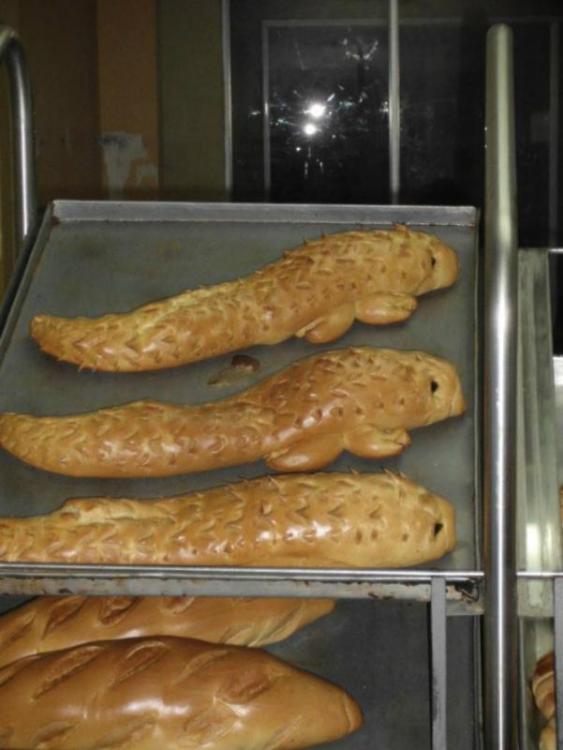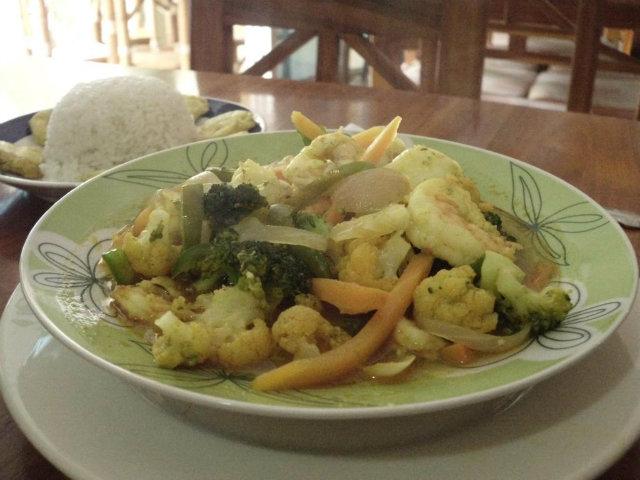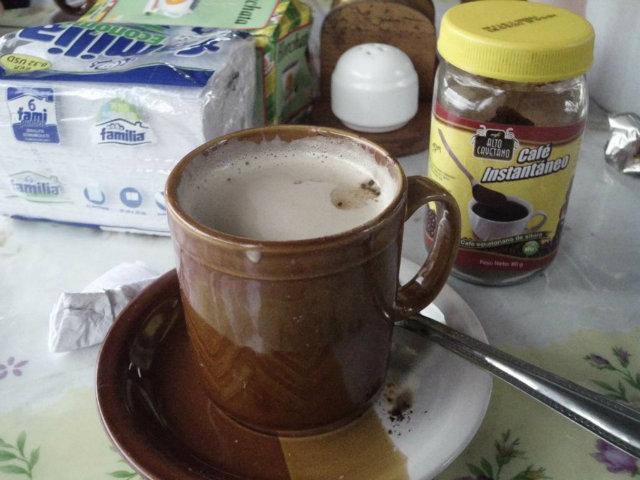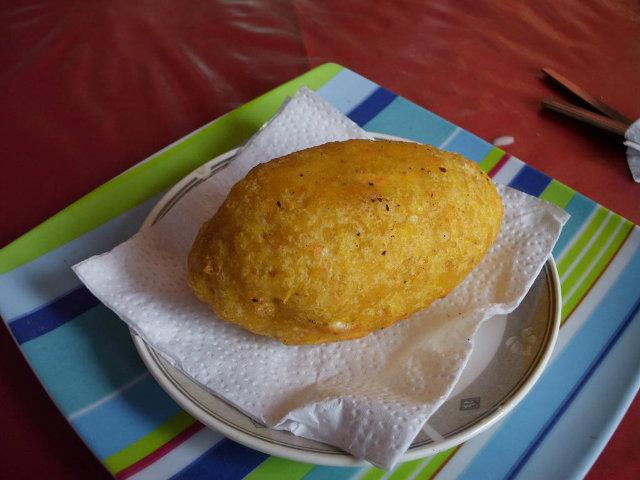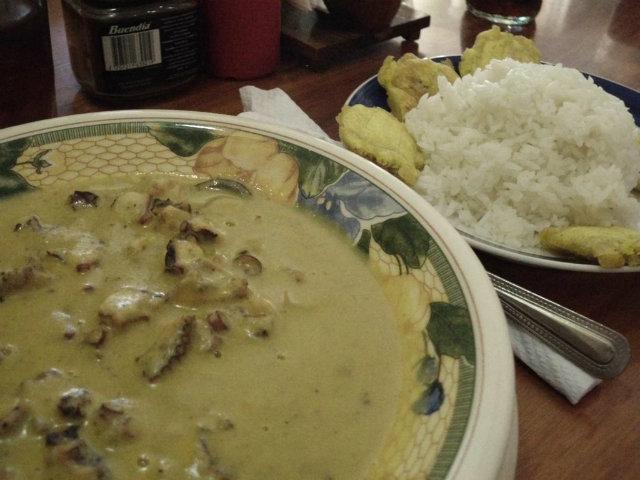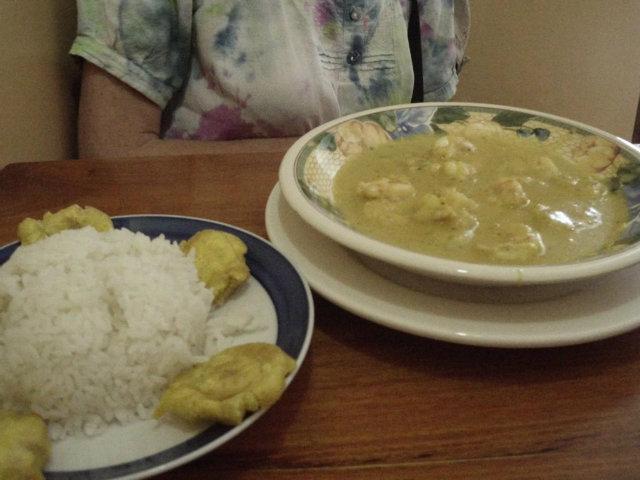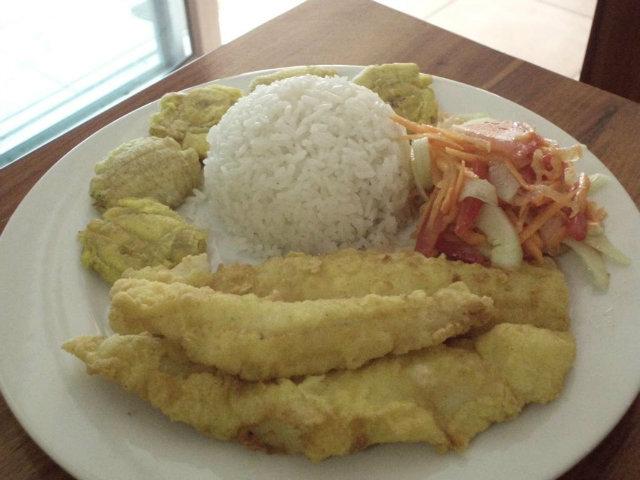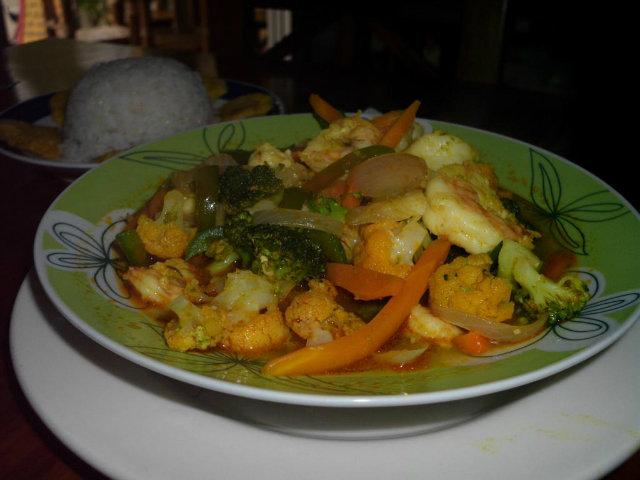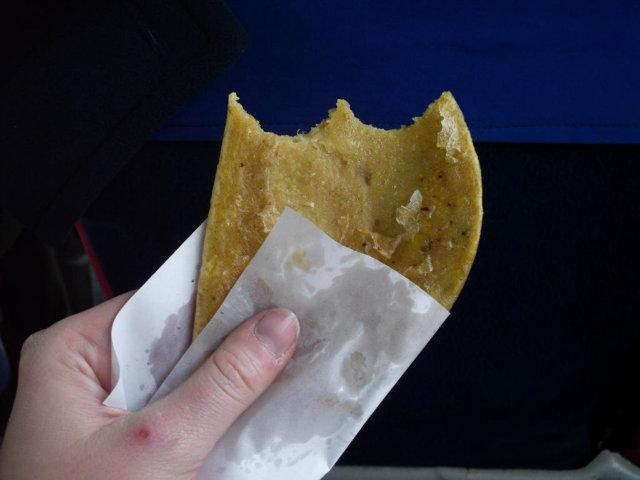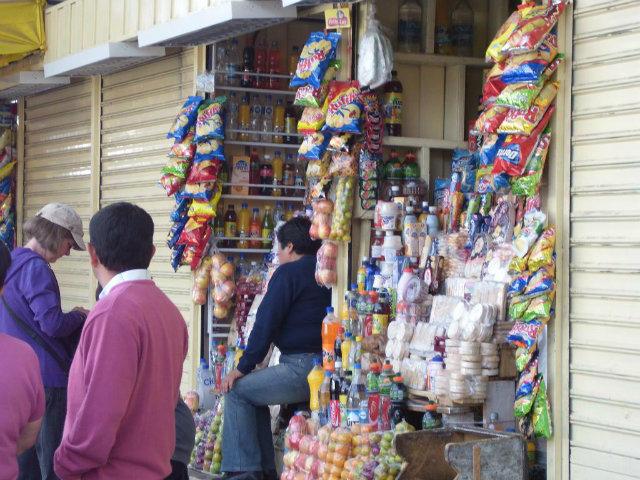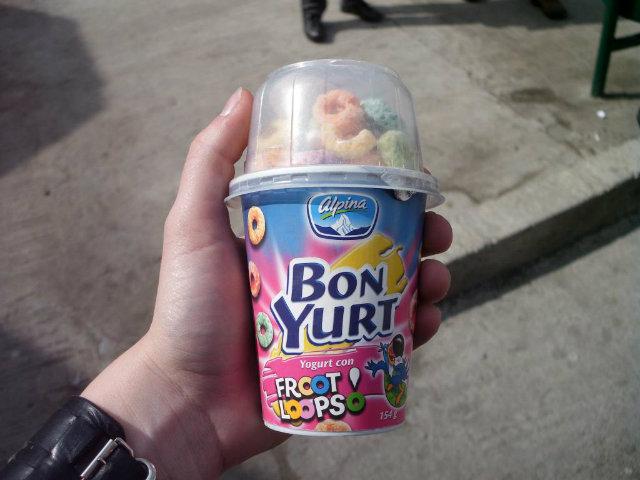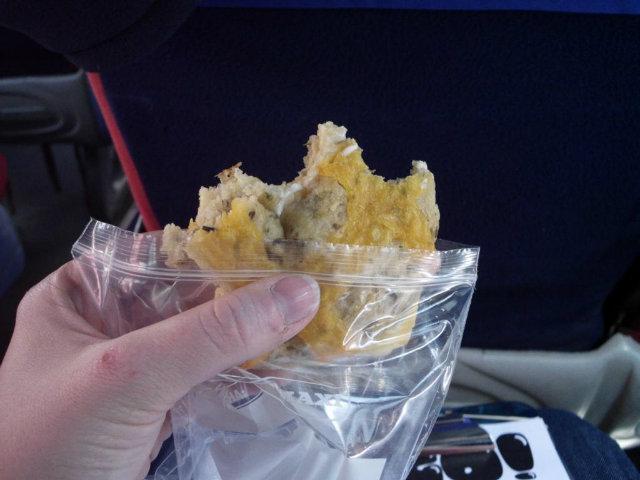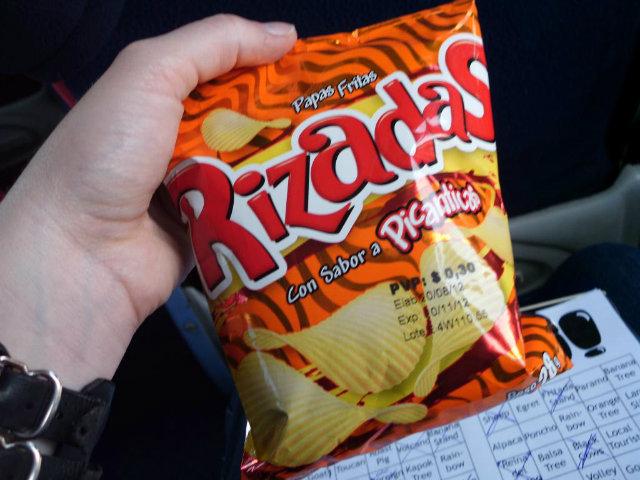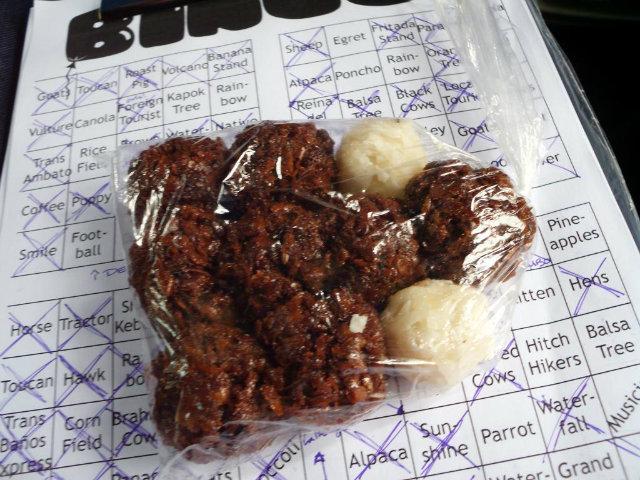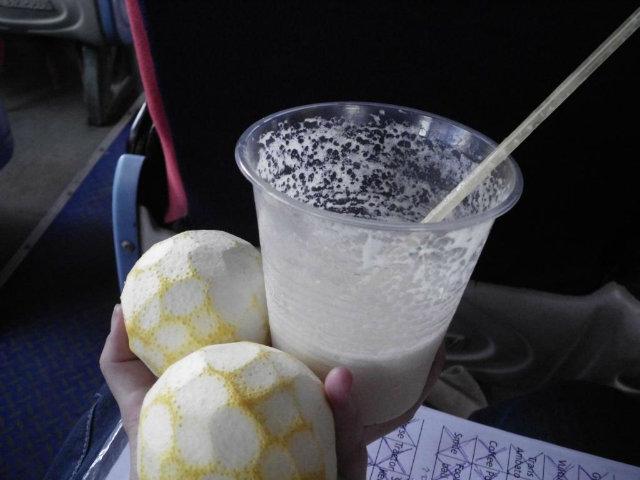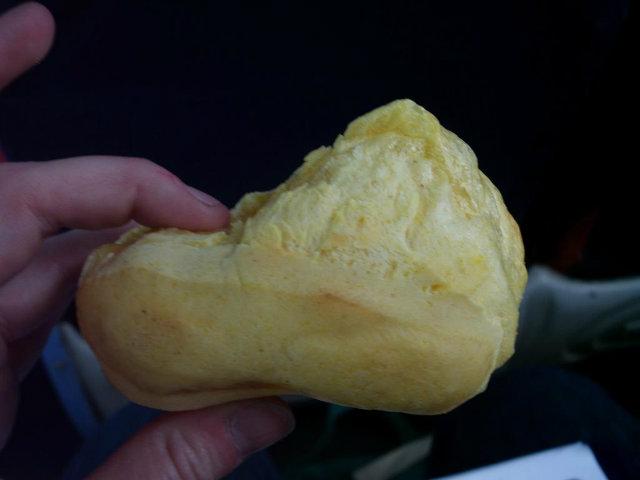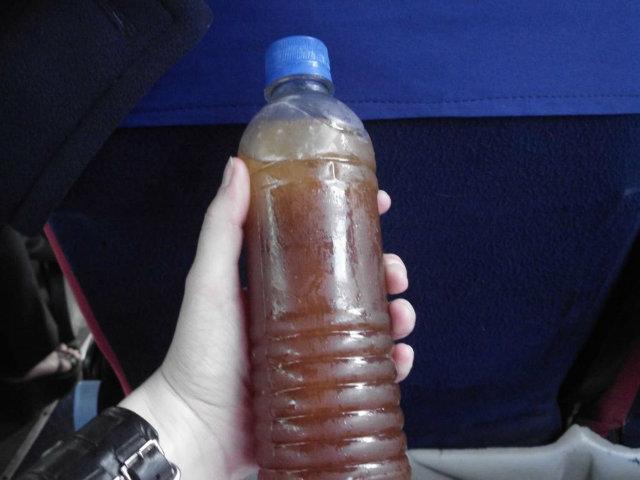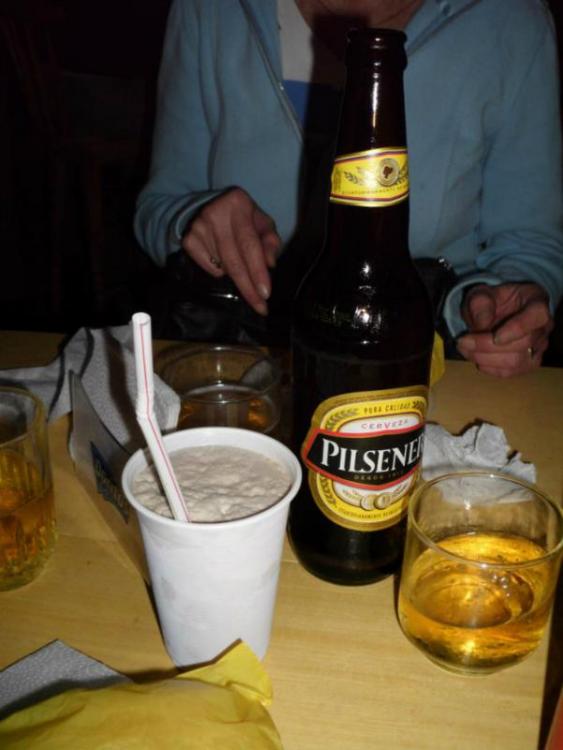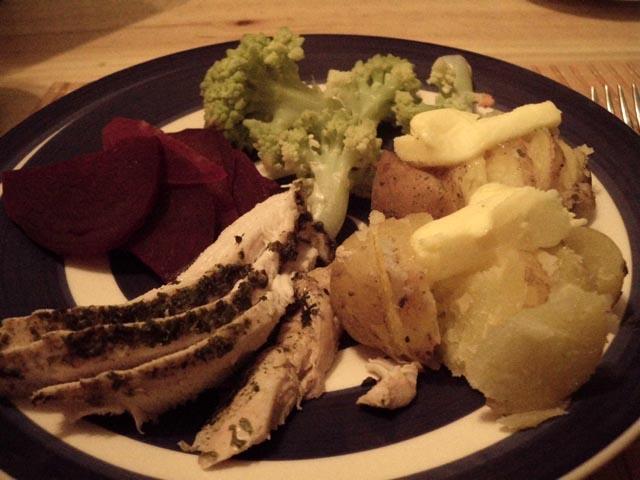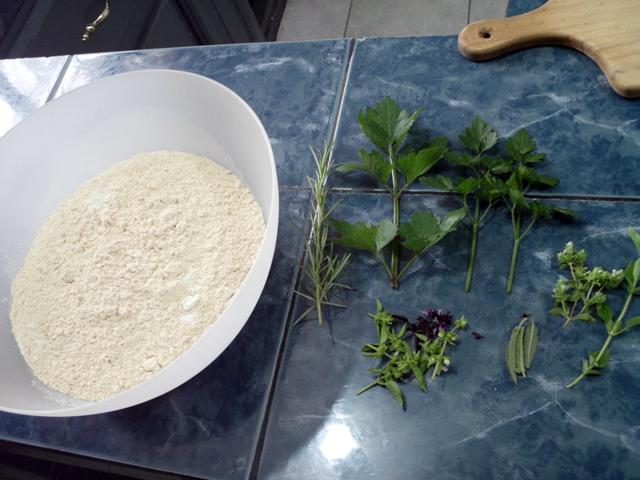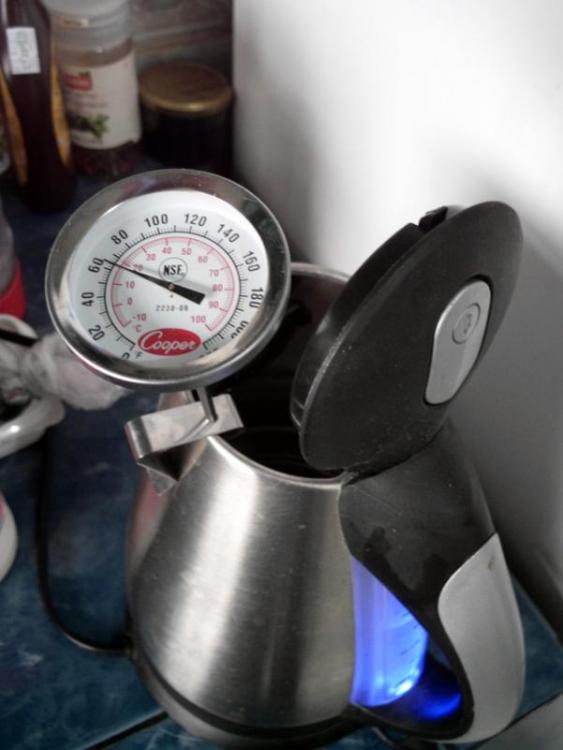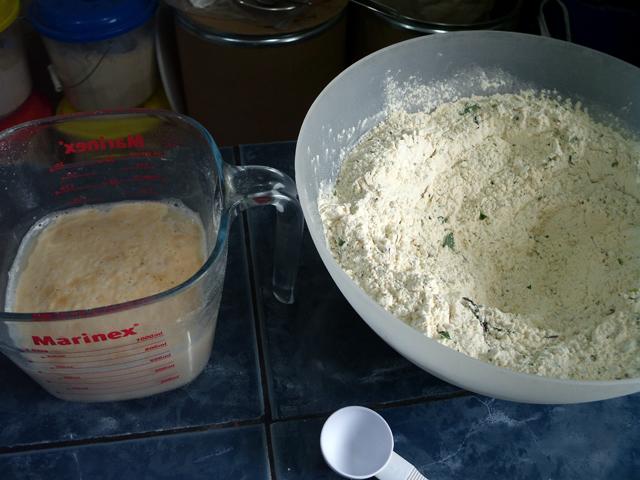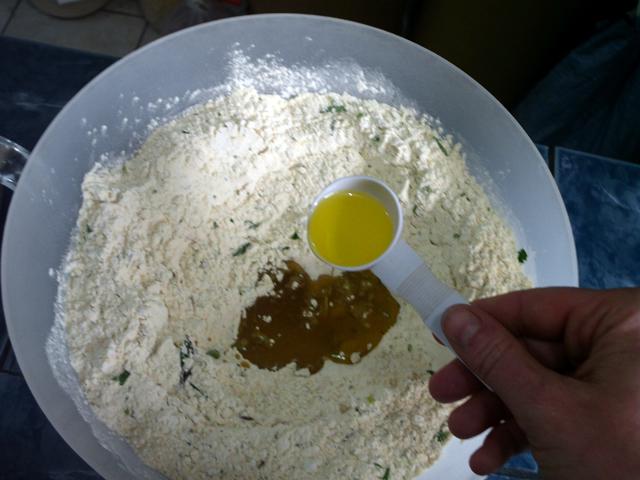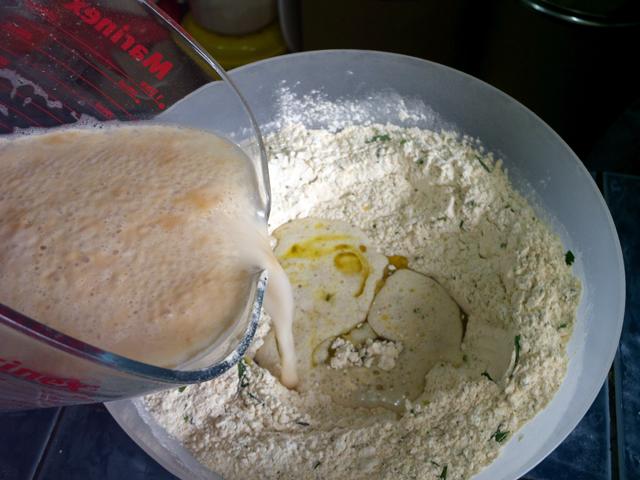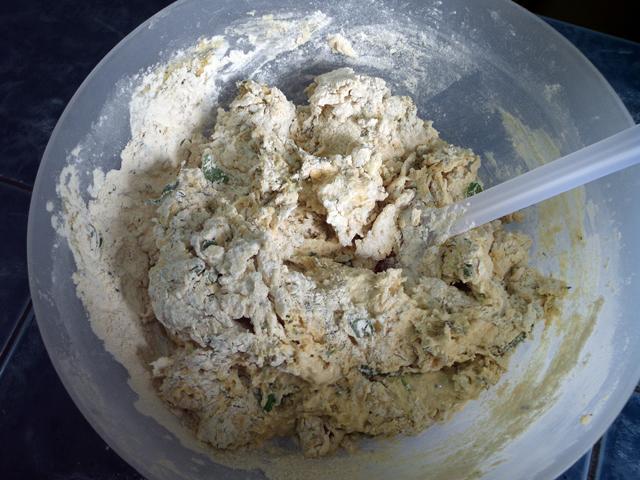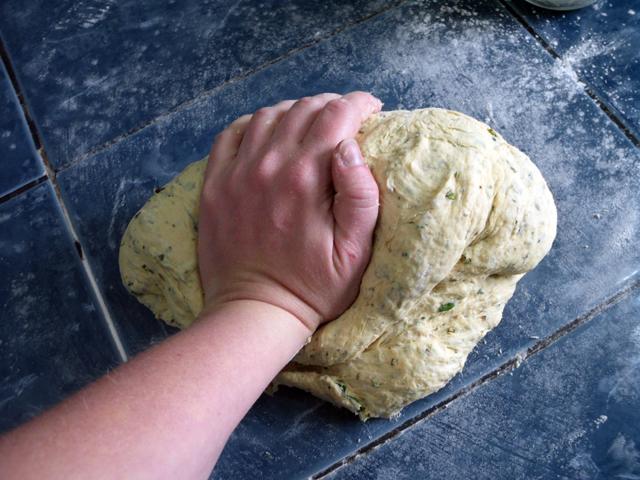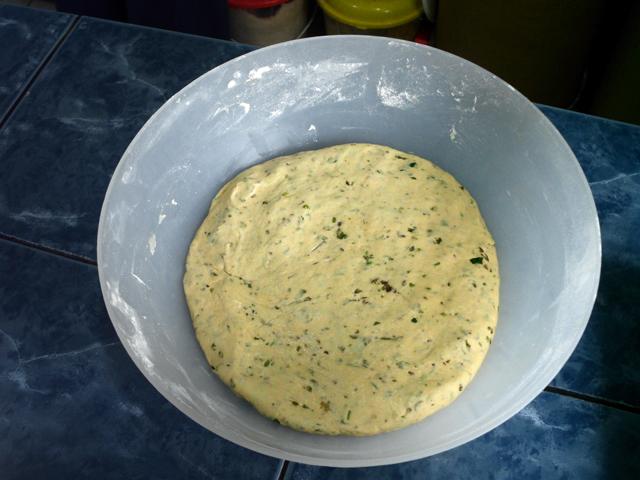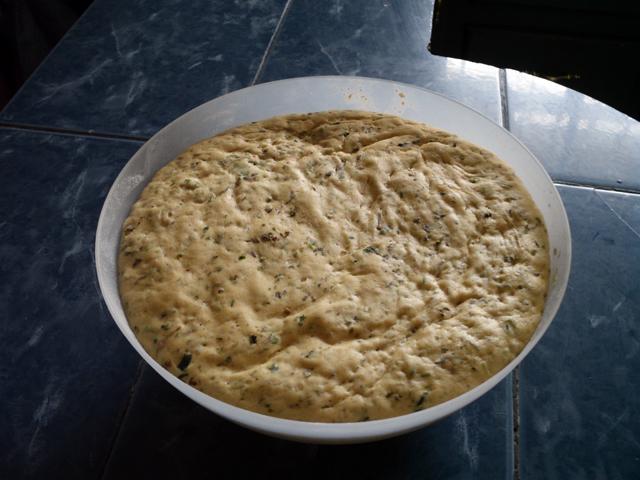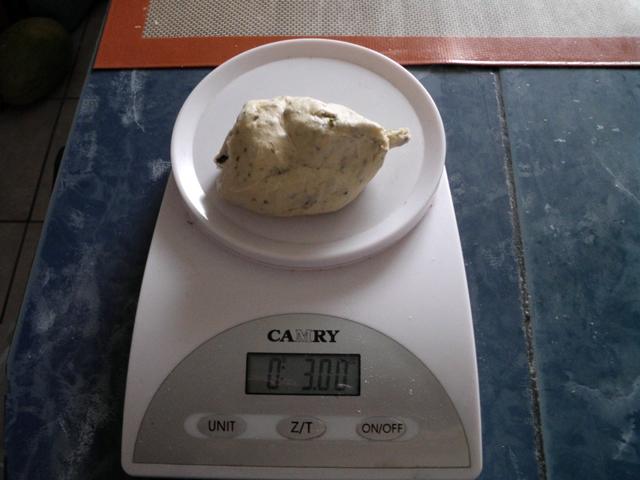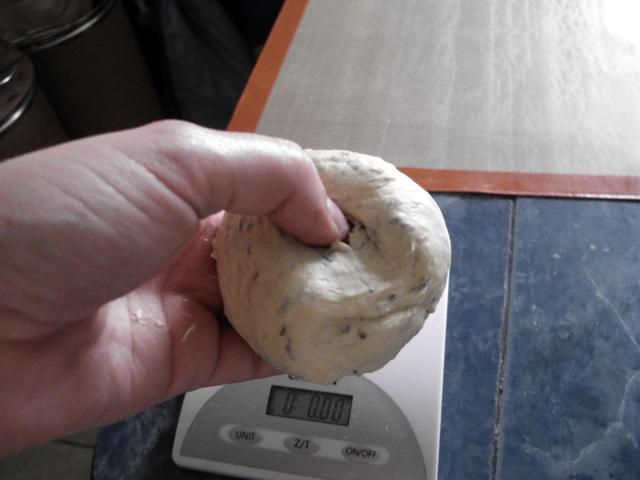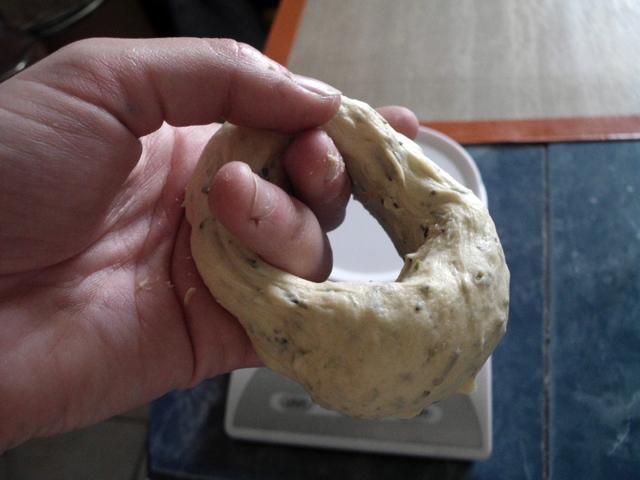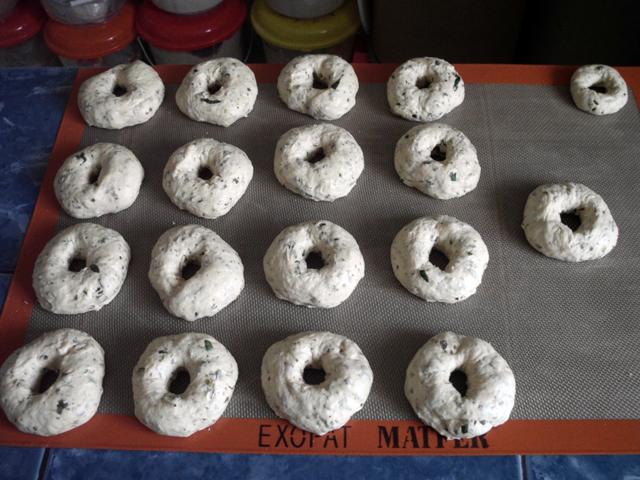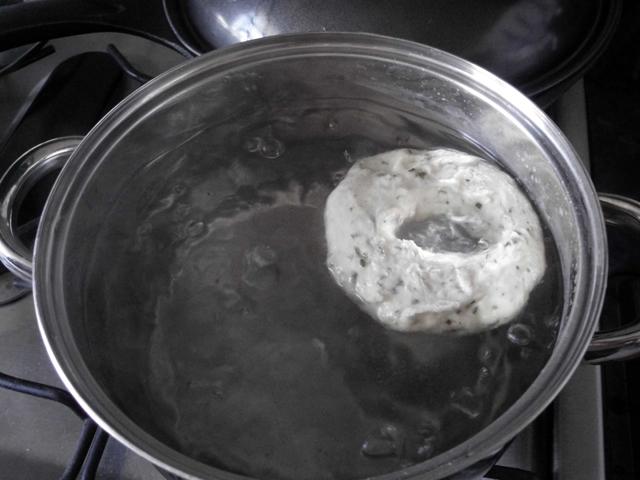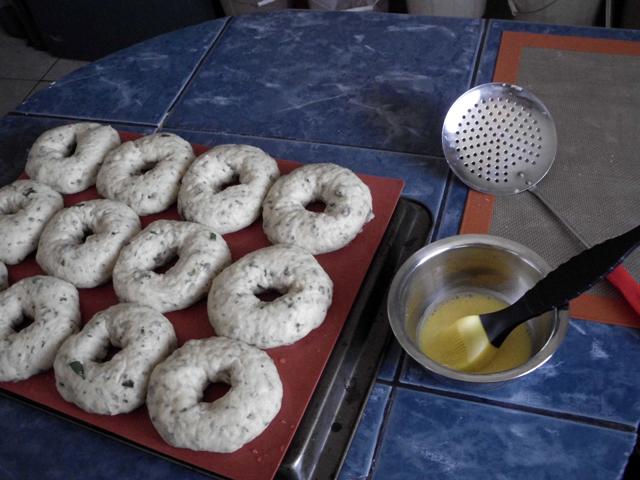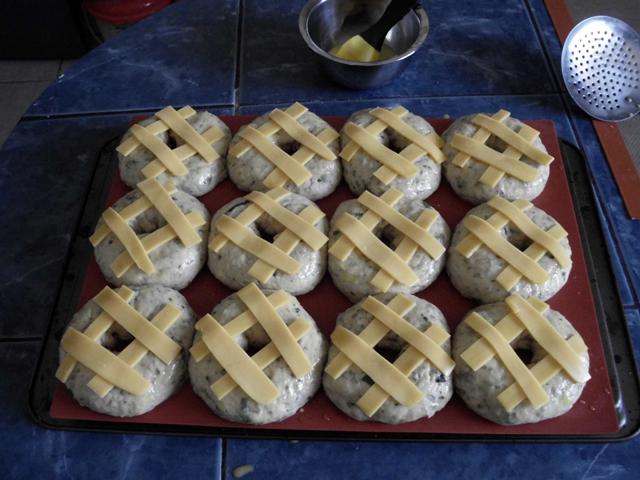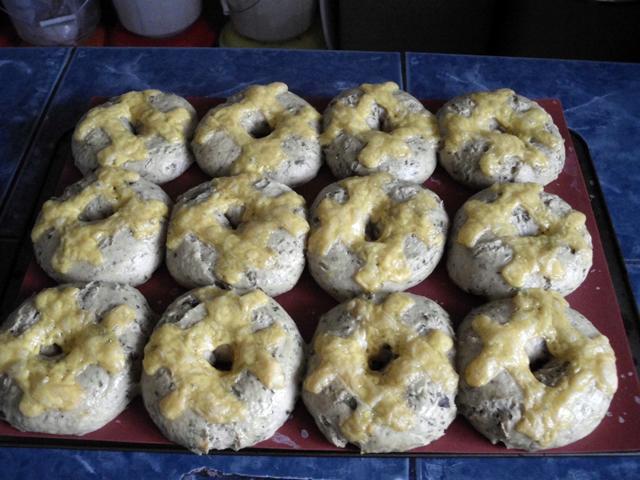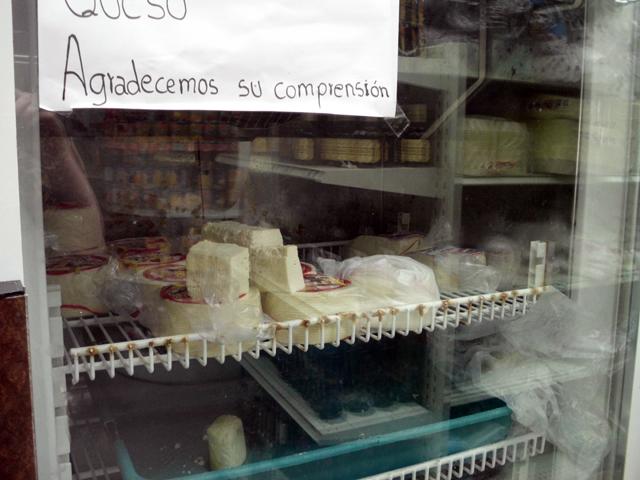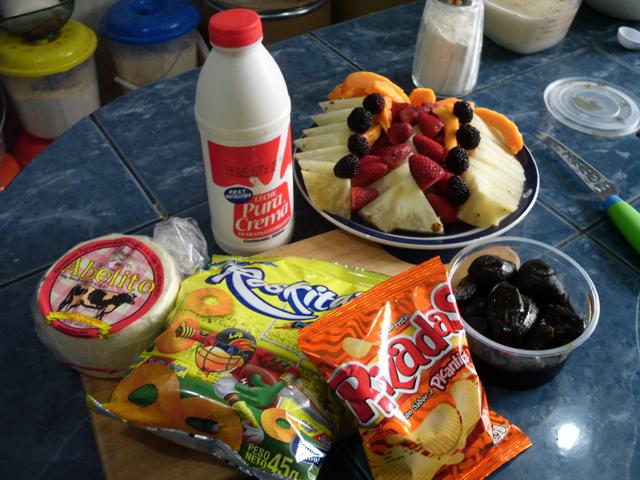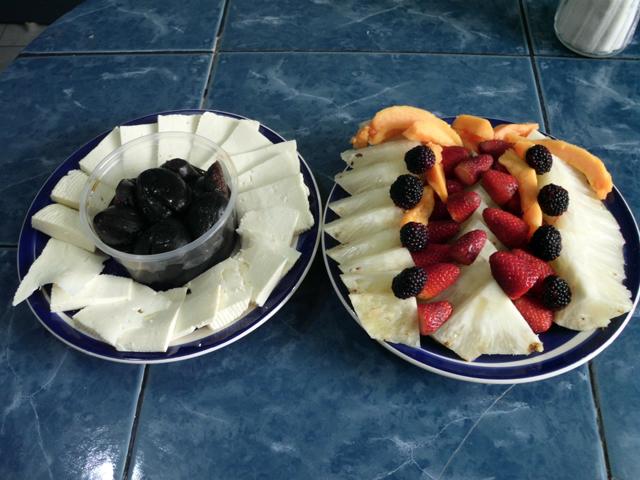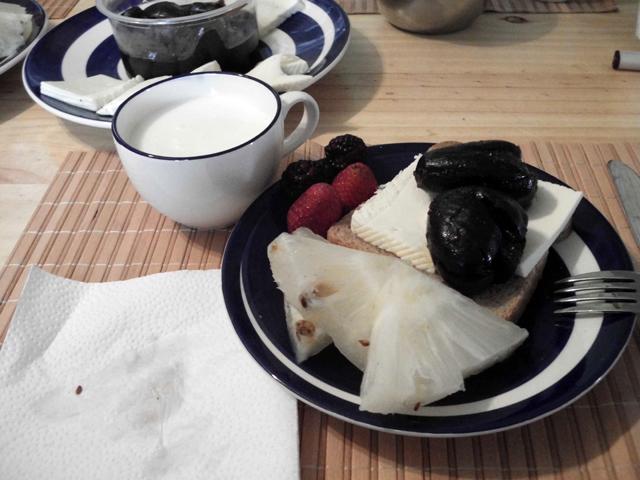-
Posts
2,383 -
Joined
-
Last visited
Content Type
Profiles
Forums
Store
Help Articles
Everything posted by Panaderia Canadiense
-
And to finish off, here's Sunday. We had Helado de Paila for breakfast - what was freshest were the fruit flavours, so that's what we got: Maracuyá, Mango, and Taxo. Lunch was a simple affair - a big bottle of Pilsener, split four ways, and pasta carbonnara. Not much is open in Quito on Sundays, and we were thrilled to encounter a sidewalk cafe that wasn't selling seafood! And dinner? That was plan B. The restaurant we wanted to go to, Boca del Lobo, had a little sign on the door saying ''I'm on vacation, no sittings tonight'' so we went to El Arabe for Syrian instead. The chef, Salaama, is a good friend of the family, and he stuffed us with all manner of delicacies. Hummus and Metabel (attacked so quickly that I didn't get an establishing shot!) Shislik (marinated tenderloin beef cubes over carbon) Chicken Special (the menu simply calls it ''unmissable'' - it certainly was!) Mixed lamb kebab Felafel ''Oh, just bring me something tasty, please'' - ended up being an eggplant stuffed with lightly spiced ground lamb, very good! And the ever popular, bit of everything plate. Everything was delicious; I'm going to go pass out now.
-
Yesterday was a trip into the northern hemisphere (it's possible here, and yes, I stopped on the equator and stood with one foot on each side of the line - I do it every time I pass!). Breakfast was a mochaccino and a slice of mora cheescake. Thoroughly lovely. And onwards and upwards to Otavalo! This town, in the province of Imbabura, hosts the world's largest indigenous market, which is at its peak on Saturdays. Despite what it may look like (it was in fact a balmy 23 C), it's winter here right now, which means that the market is primarily dedicated to alpaca products (everything from scarves and sweaters to alpaca leather slippers and rugs). In the summertime, it switches over to cotton, which is grown in the surrounding areas. The outskirts of the market are farmers' territory, although everything is sort of mixed in together. It all spans an area of about 100 square blocks. The Otavalos are an autonomous government within Ecuador, and are perhaps one of the most successful native groups in the world - all commerce here is owned by guilds of producers and goes back into the community's wellbeing. If you've ever seen Alpaca Camargo branded woolen goods up north, this is where they're made. In the van on the way up, we ended up stopped at a traffic jam. Lovely sunny day that it was in the desert between Quito and Otavalo, enterprising souls were selling ice creams. From left to right, these are: coconut-strawberry, mora-cream, and coconut-cream. And here's the market at Otavalo itself. I am now kicking myself for not taking more photos for you, but we were heavily into the shopping vibe. The outskirts are an interesting blend of commerce - here dry goods are being sold right next to clothing. Lunch here was a hastily grabbed fast-food chicken sandwich and fries. Caravana is a locally owned franchise with (and this strikes me as slightly odd, since I'm used to the North American method of doing things) table service. The food is inexpensive, fast, and reasonably tasty, although I must say I'm not a fan of the untoasted, soggy buns. Dinner, however, more than made up for lunch's faults. This is one of the best things that can be eaten in Imbabura province.... Just north of the provincial capital, Ibarra, lies Lago Yaguarcocha, site of a famous battle between the Inca and the preincan Ibarra culture. It's now a destination for locals to relax and spend a pleasant afternoon; we arrived as the moon was rising over the ridge and my photos didn't turn out at all, but we were really here for the fish. The lake is an extinct volcanic crater fed by subterrenian springs, and it has been stocked with Tilapia, which grow to an enormous size in its cold, clean waters. Numerous eatieries devoted to catching and cooking these fish line the banks of the lake. Between five of us, we managed to devour three Tilapia, two of which were classed as ''small'' (they were only 25 cm long, and about as broad), and one of which was a ''medium'' (30+ cm and fat!). For reference, the inner surface of that plate is 30 cm long. The fish was lightly flour dredged and then fried in hot oil, and came to us still sizzling. On the side, you can see patacones and some fried yuca as well. The fish had been out of the lake less than 5 minutes, and it is probably the best in the world (and I've eaten a lot of tilapia in a lot of different places). *slurp* *burp* *yum* Needless to say, I never visit this province without visiting the lake. Cheers! Sunday is my mother's birthday, and we'll (with great luck) be dining at an Ecuadorian haute cuisine restaurant, so I can show you how one of the country's more famous chefs treats what you've been seeing all week. Off to reserve a table! (For the curious, the restaurant we'll be going to takes reservations in the morning for the evening's dining, and you have to make them in person.)
-
Update time, part 1: Bus trip from Hell, to Quito. This was a second opportunity for two things (besides a roadsore tush and a serious nap deficit): bus food, and bus bingo. I won the bingo, and in keeping with this blog's theme of not eating the same things twice (I omit coffee from this, of course) here's the haul. Pretrip, it was back to the comedor for a last cup of coffee. We got there before the fishermen, so I can actually show you the establishment. It's three plastic tables, about 18 lawn chairs, and a cooking nook. For breakfast, a Tres Leches purchased from the bakery across from the bus stop. This was a fabulous example of the dessert - a piece of Brazo Gitano (a rolled cake but in this case with a condensed milk filling) bathed in vanilla cream, with whipped coconut cream on top. It was cold and very fresh, an disappeared promptly. This was followed by a tub of Milk Fudge from the bus station in Portoviejo - not technically bus food but rather bus station food, but who's counting? This stuff is marvelous - all the flavour of gooey manjar de leche, all of the texture of smooth, creamy fudge. And I'm also going to show you the stand I bought it from, which was stocked with all manner of milk-based confections. Portoviejo is in coastal cattle country, and the main breed are Brahma cattle; the sweets available to me here remind me strongly of Indian gulabi. Next up, a scary empanada from, I think, somwhere near El Carmen. This was an ill-advised purchase, really - I was very hungry and they smelled lovely. However, it was filled with some sort of... well.... how do I describe it? Nondescript goo? Plantain, or tapioca, or what? I'm not even sure I want to consider what it was. Oh, and some shredded chicken as well. Ugh. I finished it out of sheer morbid curiousity, as I was at the time more curious about what the goo was than I was prudent about what I was eating. In other circumstances I'd probably have chucked it out the window. These coconut cookies, however, were quite nice. Sort of like mildly coconutty digestives. And the final thing I was able to get on the bus, before the driver decided to close his doors and push onwards like a mad fiend, were in the town of Chone, and were a pair of coastal specialties: Muchines de Yuca and Corviche. The former is finely grated yuca (manioc) formed into sticks around cheese and then deep fried. The latter is plantain dough around a fishstick, also fried. The muchine (gold) was stellar, the corviche (brown) uninspiring and dry. We woozed into Quito at 10 pm, and the only thing open, bless its caffeinated little soul, was Coffee Tree, a 24-hour latte joint. Mochaccinos for everyone, and off to bed!
-
Hi folks! No, I didn't fall off a cliff on my way back up to Quito, but it was the bus ride from hell (12 hours, the last three of which on twisty mountain roads in peasouper mist, and the driver didn't want to stop anywhere for bathroom breaks, and in fact wouldn't until all of the women in the bus threatened to pee on his seats...) Yesterday was reserved for the world's largest indigenous market, and I left before internet cafes opened and returned after they had all closed. I have megaupdates coming your way. Depends on where in the country you choose to travel. Beach places, like Puerto López, tend to have a high percentage of multilingual people living and working there - the restaurant where I had the shrimp arepa, for example, is owned by a Colombian-Ecuadorian couple who also speak English, French, German, and ISL. However, the place in the market where I went for 6 am coffee? That's Spanish only, since it's not somewhere that a tourist is normally likely to venture. Since I'm not really a tourist, I knew to look for it, but anybody who's just vacationing would never have even thought to go to a market comedor. Highland and jungle places, outside of major cities, are less likely to have English speakers in them. However, almost the first vocabulary that any decent traveller in a foreign country accumulates (apart from please, thank you, and pardon me) is to do with food, so it's not really all that difficult even in areas where a little English isn't spoken. I learned basic Spanish by hanging out in farmers' markets in small towns in the south of the country, and asking ¿Qué es esto? (what's that?) You figure out pretty quickly what you like and don't like, and for the first while I kept a little list in my pocket with translations of most of the more common foods, so that I could figure out menus quickly. If you like shrimp, for example, you'll learn pretty quickly that they're the camarones on the menu. What took me the longest was figuring out the difference between Langostinas and Langosto (crayfish and lobster, respectively) as the seasons for both are relatively short and even if they're on the menu, they're not necessarily in the kitchen....
-
Radtek, have you tried the lye with doughs high in non wheat grains? I will, of course, but it would be interesting to know if it has the same effect on lower gluten preparations..... The Arepa Hogao is actually Colombian food with an Ecuadorian twist (and it is fairly common style of fusion here). It is also very easy to make at home. Once I get back to semicivilized Quito, I will borrow my friend`s fusion cookbook and find the recipe for the Hogao sauce.
-
As promised. The chef actually apologized because the 12 inch long lobsters were not very big, so she included two on the plate. I ordered them al ajillo and they came perfectly done. Slurp. I would like to mention at this point that up to the lobsters, none of the plates I have shown you have cost more than 8.00 USD (the lobsters cost 20.00 USD). Not only am I eating amazingly well, I am also doing it without breaking the bank. My dining companions opted for Langostinos a la Plancha (giant estuary crawfish on the grill) and simple chicken medallions. Belch. I am so full of seafoody goodness that I am completely ready to just waddle back to my hotel and fall into bed. Which would definitely be the plan if I didnt have to pack.... Tomorrow is another travel day, so look forward to a late update with all new bus food!
-
Sorry for such a long delay in updating, folks - the guide knocked on our door bright and early this morning to tell us that the sea was finally calm enough to make the crossing to Isla Plata, which is the real reason I'm on this particular beach rather than one that's closer to home. (And to be clear, ''calm enough'' translates as ''the swells are only 2 meters'' - lucky for me, I don't get seasick even in much higher seas.) To this point in the day, I've had a cup of Nescafé, a banana, and a hastily devoured mortadela and queso fresco sandwich, none of which was photographed simply because it was one of those ''eat it quick or the sea turtles will get away'' things. But I'm getting ahead of myself! Dee: I'd have to go to either McDonalds (eewwww) or a really scuzzy restaurant (one that does not meet my admittedly rather simple criteria) before I ever saw foam plates - even beachfront shacks and the roughest comedores here have beautiful melamine or china tableware. I think it's part of the country's zero tolerance policy for non biodegradable anythings. Even the plastic bags I take home my groceries in are oxi-biodegradeable plantain and corn based plastics. Last night's dinner was another Manabita specialty: Corvina de la Roca (Chilean seabass) al ajillo with a cilantro crust, in Salsa de Mariscos (seafood sauce). Every chef here does Salsa de Mariscos a little differently; on my last trip to the beach, it was a cream-based sauce with chunks of lobster and shrimp in it. This time around it was tomato based and filled with succulent squid squiggles, tender chunks of octopus, huge shrimp, small mussels, and some several concha (a type of mangrove clam that I have only ever seen in Ecuador). On the side is a rice preparation I've only ever had on the coast - I have no clue what's in it, and it looks like regular white rice, but one bit says it's clearly not. I am embarrassed to say that this dish conquered me - it was so rich and filling that I couldn't finish it, and had to settle for picking my favourite parts out of the sauce. My dining companions went shrimp crazy, and opted for Camarones Apanado (breaded, deepfried shrimp in light beer-based tempura batter) and Spaguettis con Camarones (exactly what it sounds like, with a red sauce based on shrimp stock and fresh tomatoes.) Now: I've had my mochachino and I'm still regaining my land legs. Isla Plata was my destination today, and as I mentioned above, I forwent my usual breakfast and lunch for the opportunity. This island is where Captain Drake is rumoured to have stashed the silver he plundered from the Spanish galleons he sacked off of Ecuador's coast (hence the name, which means Silver Island - the landing spot on it is Drake Bay), but the real reason to visit is that it's the closest island habitat to the mainland of one of Ecuador's most famous residents: the Blue-Footed Boobie. Isla Plata is a wildlife sanctuary dedicated to the birds, and conditions are such that it's rather difficult to visit it, especially in this season. I was stunningly lucky to get a space on one of the three boats that departed today, and even luckier to have been in the one that spotted the season's last Humpback Whales (they breed in these cool coastal waters when the Humboldt current rises towards the Galápagos.) So, with the risk that this become a travel blog, I'd like to share a bit of what I was here to see: Boobie mother and 1-month old chick Sea Turtles, mate And finally, some sort of Butterflyfish Unfortunately, my camera is not waterproof, so I have no photos of the hammerhead sharks, manta ray, or other reef dwellers that I saw while snorkeling. I promise to return with lobster for dinner - I'm ravenous!
-
Canola just smells and tastes bad to me; I've never really tried to analyze the off flavour. My go-to oil is sunflower, which has a slightly higher smokepoint and an excellently neutral flavour.
-
In my family, Pierogi are filled with mashed potato, sauteed red onions, parsely, and bacon; they're served with sour cream. My oma also makes a version that she calls Pedehe, which are stuffed with cumin-spiced fried ground beef and onions of some sort. Both are delicious.
-
Yeah, I thought there might be confusion there, and figured that I should explain the Ham and Cheese Iguana a little. Given that I have only ever eaten one of these in my entire life, and that the baker made no mention of alternative fillings, I suspect that they are only ever ham and cheese. However, a perverse part of me thinks that they're the coast's version of Guaguas de Pan, and I fully expect to find one full of guava jelly or something similar.... We'll see if the bakery has them tonight, and if they have some different filling. Assuming of course that I've got room left over from dinner.... The Ham and Cheese Iguana is easily the most bizarre use of bread I've ever encountered, but in a good way. Since I last posted, it's been lunchtime and cocktail hour. For lunch: no luck with encocado or lobsters within short walking distance (I did something to my foot, which is now quite sore, and I don't want to have to go too far!) but there was an Arepa con Camarones Hoga'o, which is a Colombian seaside favourite and which sounded tasty. Hoga'o (literally, ''drowned'') is a sauce based on tomatoes and green onions, in which the shrimp are poached. The arepa tasted like it was made from rice. My dining companions opted for a really stellar cream of chicken soup, and Patacone Pisa'o de Camaron Apana'o (stepped-on plantain with breaded shrimp), which was a giant fried plantain with delectable breaded shrimp on top. Of course, we all broke off bits of the patacone and dipped it in the soup, which was unlike any cream soup I've ever eaten before. Soooo yummy. Plates at the end of the meal: (and you should all know that it's entirely possible in this blog that I'll show you an empty plate or bowl and simply describe the meal to you. Yeah, I'm bad, I know it.) Cocktail hour involved Margaritas on the beach, a deadly combo to polish up a sunny day. I'm half snapped as I write this (three Margaritas later... I think I may have mentioned in my previous blog that these things are my Kryptonite....) And the catch of the day is various types of Pargo (snapper). The fishermen say it's the only thing that was running today; only one of the boats had Corvina, and only one shark came in (a small nurse shark)
-
The peanut sauce for the octopus appears to be based on heavy cream, octopus juice of some sort (I suspect some of the stock from cooking it has a role to play), achiote, and peanut butter. It's both incredibly rich tasting and incredibly thick. The dish is always served with lime to cut the weight of the sauce. Now: yesterday's catch of the day, coffee time, and ''dinner'' (the lunch having been so filling as to remove all temptation to eat anything much heavier than a crepe....) Something went hinky last night with transferring photos, but it all seems to be working today (huzzah!). Down at the fishing boats, the day's haul was coming in. Yesterday's catch was primarily Corvina (the lungfish looking ones with full body dorsal and caudal fins) and one fish that the fisherman told me was a ''Colorado'' (literally, the big red one - does anybody recognize it? It seems so familiar and yet I can't quite place it... A grouper of some sort maybe?) Bonito (these are smaller examples of this fish - they're normally about 1/4 of the size of tuna), Ocean Perch and striper, and one fisherman had a particularly lucky day and went home rich: he brought in a Picudo (swordfish) and a pair of small sharks. Billfish of any description are big-ticket items; a single one can fetch over $300. Shark is similarly valued, and has only a very short catch season (September and October) - but unlike other fisheries, all of the shark is used here. Fins are removed and sold to Asian markets, and the body is cut into steaks for domestic consumption. Cocktail hour meant a Frappucino Amaretto - yummmers. Just what every gal needs after a hard day's walkin' down the beach: a coffee milkshake with amaretto and chocolate syrup in it. One of my aunts also went for a chocolate crepe, which was lovely - a layer of bittersweet ganache drizzled with condensed milk. This is a pair of photos that aren't working even today, so you'll have to take my word for it! Dinner, if you can call it that, was a rather unlikely Ham and Cheese Iguana and some Equilibrias (domestic aguardiente rum and cola). I couldn't resist the iguana - it was just the weirdest but at the same time most appetizing thing at the local bakery. It was delicious, and also surprising, since the baker simply said it was ''salt bread'' but made no mention of any sort of filling.
-
Ah, that was Bus Bingo. Since there are four of us on this trip (myself, my mother, and my two aunts) we had cards made up for things we saw on that trip, to help us forget how looooong it was going to take. The loser buys the ice cream. I'm proud to say that while I wasn't the first to call bingo, I only had one square left and thus am not in the hotseat.
-

Unlikely Food Combos and Preparations
Panaderia Canadiense replied to a topic in Food Traditions & Culture
Peanut butter and coconut curry soup. Just sayin'. -
Alright! At 6 am, almost nothing food-related is open in a fishing village. When one needs coffee, one goes to the market and finds a comedor (tiny open-air eaterie) that has hot milk on the burner. And one drinks instant and chats with the fishermen, who, having come in minutes ago from the really early morning shift, are having dinner here. The fishermen asked not to be photographed, and the comedor was so packed with them that it was standing room only *, so all I have is a picture of the coffee itself, which was a domestic brand and much better than the usual Nescafe. Ecuadorian instant coffee tends to be micropulverized, which does something good to both the way it dissolves in milk and also the flavour. At 8, when other cafes open, we switched to a beachfront place. This was Nescafe instant, but they also had a real coastal breakfast item: the Bolón de Verde. This is a ball of green plantain stuffed with some sort of cheese and deep fried. Properly made, they're ambrosia, and improperly made, they're hideous little cannonballs of starch and lactose. There is no middle ground. This one was properly made. --Quick Aside-- * When selecting a comedor, it must meet two out of the following three criteria to be considered safe: 1. It must be clean and smell good 2. It must be busy 3. Police should eat there. Any two conditions mean you're safe. All three at once mean that you wait until there's space at one of the tables. Cops will not eat anywhere that will make them sick, and they're also good judges of economy. ----- Since my companions did not partake of the plantainy goodness, slightly later on it was brunch time. Using our usual selection tactics, we settled on a seafood restaurant on the beachfront. Oh I am so glad we did. I had Pulpo en Salsa Maní, a specialty of this region of Manabí. It's tender rings of fresh octopus stewed in a thick yellow peanut sauce, with rice and patacones to mop the yumminess up with. Words simply do not describe how scrumptious this was. There are a million ways that an octopus dish could go wrong, and this didn't hit a single one of them. My companions had Shrimp in the same sauce, Corvina Apanada (fried breaded fish, in this case a Sea Bass of some sort - Corvina is a catchall term for any mild white basslike fish), and Shrimp and Veggie stirfry. *burp* I'll be back after dinner - it's time to wander up the beach and see what the catch of the day is. The cloud of royal Frigatebirds means that somebody's cleaning something, and new boats are constantly coming in.
-
Alright folks, massive update time. I'm very sorry that I didn't get to this last night, but the journey that was supposed to be 8 hours went sort of ''planes, trains and automobiles'' on me in a very Ecuadorian way and took 12 instead (and two separate busses and a taxi), so at 10 pm when I finally arrived at the beach, all I wanted was whatever food I could lay hands on and a bed to fall into. The internet cafe was also closed. I've rested and eaten now, and with that apology let's get to it! I decided yesterday that if I couldn't get it on the bus or at a bus stop (apart from a bagel sandwich, which I had with me), I wasn't eating it - and that means you get a tour of a quintisentially important facet of travel in Ecuador, namely, bus food. In Ecuador every bus station has shops that look like these, which sell essentials and snacks. I bought a Bon Yurt (pronounced Bonjour; cost: 50 cents) with Froot Loops to start off my day right. I love this stuff - it's thin sour yogurt and just enough cereal to give it a bit of crunch. Later on, I had the bagel and cheese sandwich I'd packed for this very occasion (and you can see I was hungry, as there were only a couple of bites left when I got around to taking the picture!) and some Rizadas Picanticas, which are sort of like spicy sour cream and onion potato chips; they're my favourite flavour. Next up were Maní Dulce and Encocado Dulce, which are sweets typical of the lower highlands around Santo Domingo de las Tsáchilas, a town that is (hypothetically!) about halfway to my destination. Due to landslides, it wasn't. We took the long detour.... Maní Dulce is fresh boiled peanuts coated in crunchy salted panela candy with sesame seeds. Encocado Dulce, on the other hand, is balls of coconut and ginger in a sort of molassesly type syrup. Those who have been to Jamaica are familiar with this sweet as a tart filling; Ecuadorians bypass the pastry and roll it into balls. Whichever way you slice it, it's delicious. The brief lunch stop made by the bus driver was in Puerto Carmen, and that lunch consisted of a hastily grabbed Batido de Piña, some sweet oranges, and some Pan de Yuca, an intruiging tapioca-based bread with cheese. Pan de Yuca is made differently in each province; this is the first time I've ever had one with a yellowish dough. Batidos also deserve an explanation - they're fruit frapped with ice and either milk or yogurt; in this case, yogurt. Sort of like smoothies, but with extra pulp. About 3 hours later, a fellow got on selling Empanadas de Verde, which have green plantain dough and in this case a pleasantly spiced chicken and mashed potato filling. Just about anything can come stuffed into an empanada shell, so it's always worthwhile to ask before you buy. These were extremely fresh, having just come out of the oil at the roadside stand. To drink, because at this point we were definitely into the coastal hills and it was 36 C in the bus, I bought a bottle of frozen tamarind juice, sort of a bus version of a slushie. Tamarind is stupendously refreshing when it's cold. This was hour 8 of the trip, and the empanada man was the last vendor to enter the bus. Finally, as I dragged my weary butt to the beachfront. The only remaining place with food was a burger joint, so we all got a round of cheeseburgers (and the fries were on the burger rather than the side!), a chocolate shake for me, and 1L of beer (the big bottle) split three ways for my travelling companions. Hunger is really the best seasoning - I wouldn't normally touch a burger like this with a 10 foot pole, and I'm not entirely certain what the meat was (if indeed it was meat - I'm not entirely convinced it wasn't tempeh, and I was waaaay too tired to ask) but at the time it was the best thing I had ever eaten. Mission accomplished, I returned to my hostal to find a kitten napping on my bed, debated what to do for five seconds, crawled in next to it, and passed out. Next up: what to do in a tiny fishing village when it's 6 am and you need coffee, right friggin' now....
-
Cecilia potatoes are a particular local cultivar - they have reddish skins, gold meat, and if you cook them even a hair too long they disintegrate into starchy moosh. They're generally considered to be the ideal potato for Locro (thick potato-based soups) since if you peel them and toss them into a broth, they'll dissolve completely. It is through great trial and error that I have learned how to bake these critters - they take far less time than other potatoes of similar size, and are best done in a pot with only a little oil. I generally cook these with turkey because they're a reliable indicator of when the meat is cooked - when the smallest Cecilia starts to crumble, it's time to eat. I go to the trouble because they're delicious. Even without butter they have a very creamy flavour and a delicate texture that I really like. Incidentally, my normal baking potato is called Atahualpa or Chola; those have red skin with white polka-dots and sometimes have purple stripes inside as well; they're waxier than Cecilias and can bear overcooking.
-
Yeah, the Maillard reaction seems to have a weird delay with the quinua flour. Those bagels have perfectly textured crusts, but if I cook them until they're browned they'll be hideous and dried out inside. I've had some success turning on the broiler for the last 5 minutes of the bake process, but it's never a guarantee and they won't brown evenly. So I just don't worry about it - I get excellent browned crusts on my non-quinua breads.
-
Anna, I expect you'd make an exception down here. A pineapple that was picked yesterday, ripe, is miles different from one that was picked green, shipped, and then gassed at 3 weeks of age and sold in a Canadian grocery. Lunch here was a bit of an undertaking, but since we're on an 8+ hour bus ride tomorrow it made sense. I made quinua-herb and cheese bagels. For the interested (and bearing in mind that a peculiarity of my altitude is that I have to use about twice as much yeast as a sealevel baker needs to), it's a very simple recipe: 1 part quinua flour (250g) to 4 parts unbleached white (1000g), all the herbs you want in it (I used flat parsely, lovage, basil flowers, sage, and oregano), 15 mL of salt, 2 parts (500 mL) of water at 50C, 1 oz of yeast, and about 120 mL of olive oil (I use EVOO). Start by mixing the flours, salt, and herbs. Once the yeast is proven, it gets added in along with the EVOO. The whole thing is stirred until it's a sticky mass, then turned out onto a floured surface and kneaded until it's smooth and elastic. And that goes into a bowl to rise for a couple of hours. My dough was a bit stiff, so I left it a little longer than usual so that it would slacken up a bit. It's a roughly 40% hydration dough, and it should turn out quite slack. That gets punched down and divided into 3 oz balls (this being what I consider to be an ideal bagel size for this dough). Bagels are formed by pinching through the middle of a ball and then stretching the hole out. And those get set on the Exopat to proof for about 20-30 minutes more. Once proven, I boil the bagels in very salty water for 15 seconds each side. Those get flopped onto a silpat, brushed with egg, and covered with cheese strips. Into the oven for 25 minutes at 375 F And schmeered with cream cheese when they come out.
-
What a fascinating name for a fruit! Thank you so much for blogging Elizabeth; this is a completely new culinary world for me It's actually a pretty logical one. The native blackberries are called "Zarzamora" (literally, wild purples), so when the Spaniards brought theirs along they were called Mora de Castille or Mora de Castilla to differentiate them from the natives.
-
That's water, not knives, and this close to the equator the coriolus effect is negligable - it all comes down to the way your sinks are scuffed. Breakfast time! This being Blog Sunday, we went with "Ecuadorian Sunday Breakfast" which is basically a fruit and cheese buffet with bread, yogurt, and coffee. However, horror of horrors, when I opened up my wheel of Gouda there was a scary colony of green mold living in it. This meant a trip to the tienda up the hill for some Queso Fresco, because you can't have a breakfast buffet without cheese! This is the queso fresco cooler; the owner of the tienda didn't want me to take more photos of the shop (she said it was disorganized! Even on its worst days, this tienda would put a Japanese supermarket to shame....) so I don't have more. It's basically a micro supermarket with a small bakery tucked into one corner and a butcher's shop at the back. There's a sign on the cheese fridge asking customers rather politely to ask for a bag before they select their cheese, so as not to drip whey all over the market floor. And, because I'm a horrid impulse shopper, I also picked up a tub of candied figs in syrup, a bottle of milk, and some salty snacks for the road tomorrow. Roskitos are expanded corn rings that taste exactly like popcorn; Rizadas Picanticas are sort of like spicy sour cream and onion ripple chips. Here's the final version of breakfast (loaf of bread not shown). On the fruit plate is Abacaxi pineapple, Sunrise papaya, strawberry, and Mora de Castille. On the other plate is the tub of figs and sliced QF. Personally? I built myself a fig sandwich and had some fruit on the side, and a mug of yogurt to drink. My aunts also availed themselves of Quimbolitos (which will be my breakfast tomorrow) which we had in the fridge.


